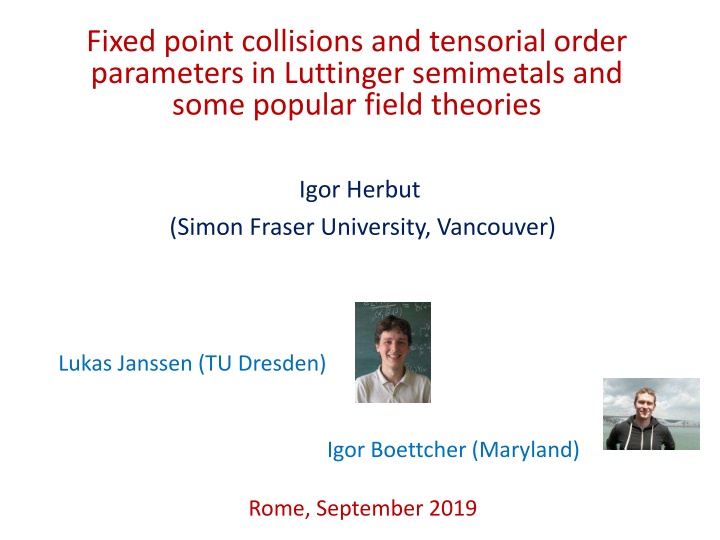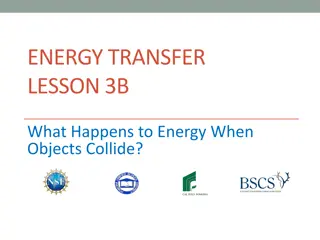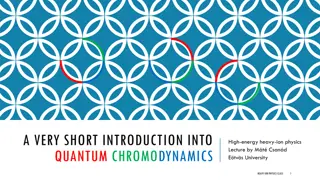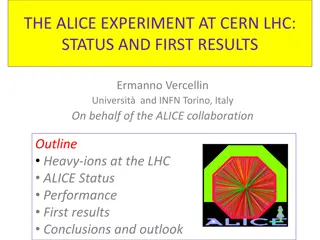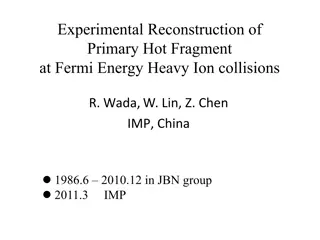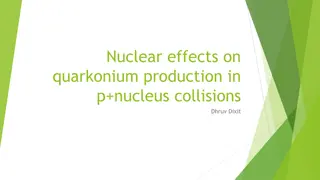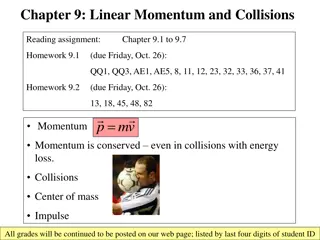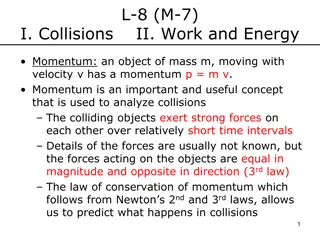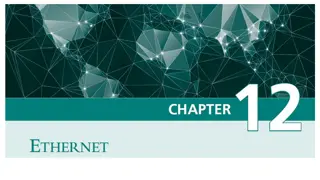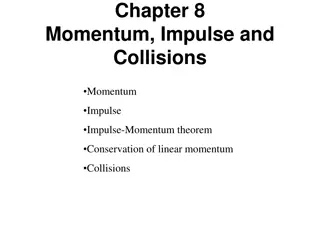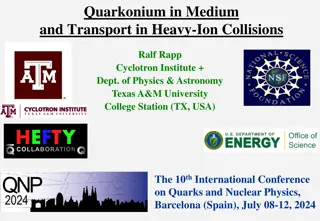Fixed Point Collisions in Luttinger Semimetals and Field Theories
"Exploring fixed point collisions and tensorial order parameters in Luttinger semimetals and various field theories, such as chiral symmetry breaking in QED and Interacting O(N) field theory. The research delves into the condensed matter motivation behind quadratic band touching and the Luttinger Hamiltonian, as well as the implications of long-range Coulomb interactions and emergence of non-Fermi liquid phases. The work also discusses the generation of short-range interactions in the context of the free Luttinger Hamiltonian."
Download Presentation

Please find below an Image/Link to download the presentation.
The content on the website is provided AS IS for your information and personal use only. It may not be sold, licensed, or shared on other websites without obtaining consent from the author.If you encounter any issues during the download, it is possible that the publisher has removed the file from their server.
You are allowed to download the files provided on this website for personal or commercial use, subject to the condition that they are used lawfully. All files are the property of their respective owners.
The content on the website is provided AS IS for your information and personal use only. It may not be sold, licensed, or shared on other websites without obtaining consent from the author.
E N D
Presentation Transcript
Fixed point collisions and tensorial order parameters in Luttinger semimetals and some popular field theories Igor Herbut (Simon Fraser University, Vancouver) Image result for lukas janssen Lukas Janssen (TU Dresden) Igor Boettcher Igor Boettcher (Maryland) Rome, September 2019
Outline: 1) Condensed matter motivation : (symmetry-poorreal world) Quadratic band touching in three dimensions, and the Luttinger Hamiltonian Coulomb interaction and the scale-invariant ( non-Fermi liquid ) fixed point Fixed point annihilation and the concomitant separation of scales Spin-2 (tensor) order parameter 2) Field theory applications Chiral symmetry breaking in QEDd<4 revisited Interacting O(N) field theory above four dimensions
Image result for gray tin Image result for gray tin Gapless semiconductors with band inversion (gray tin, HgTe, YPtBi ) Luttinger (spin-orbit) Hamiltonian (p-orbitals, J= 3/2) (Luttinger 1956) with (rotationally symmetric) eigenvalues
Luttinger Hamiltoniana laDirac: where, are l=2 (real) spherical harmonics. Five 4 x 4 Dirac matrices satisfy Clifford algebra:
Long-range Coulomb interaction (1/q^2) : without the hole band, at ``zero (low) density: Wigner crystal With the hole band filled and particle band empty: the system is critical ! In the RG language, the charge flows with the change of cutoff, to one loop: (Abrikosov, ZETF 1974; Moon, Xu, Kim, Balents, PRL 2013)
Below and near the upper critical dimension, dup = 4, the flow is towards a non-Fermi liquid fixed point, with the charge at and the dynamical critical exponent Z < 2: This implies power-laws in various responses, such as specific heat: Emergent scale ( conformal ? ) invariance! Cheap way to get a non-Fermi liquid phase in 3D !?
Generation of short-range interactions: (IH & Janssen, PRL 2014; Janssen & IH, PRB 2017, Boettcher & IH, PRB 2017) with the free (Luttinger) part, and long-range (Coulomb) and short-range (Coulomb) interactions
The RG flow of all the couplings: (one loop) with, and the charge
One-loop at face value: close to and below d=4 there is a (IR stable) NFL fixed point, but also a (mixed-stable) quantum critical point at strong interaction: They get closer, but remain separated in the coupling space!
At some lower (non-integer) critical dimension d=dl NFL and QCP collide: In one-loop calculation this occurs at , slightly above three dimensions.
Finally, below dl the NFL and QCP become complex , and there is only a runaway flow left in the physical (real) coupling space: g2 diverges at a finite scale: the system is unstable, towards a new phase (gapped (Mott) insulator). Scale invariance lost!
Fixed point collision and annihilation: (Halperin, Lubensky, Ma, PRL 1974; IH & Tesanovic, PRL 1995; Kaveh & IH, PRB 2005; Gies & Jaeckel 2006; Kaplan, Lee, Son, Stephanov, PRD 2009; Nahum, PRX 2015, Gorbenko, Rychkov, Zan 2018 .)
General number of fermions (N) and dimension (d): Near d=2 the collision occurs in the completely perturbative regime:
Critical number of fermions in d=3: (Janssen & IH, PRB 2017)
The fate of NFL:if dl is above but close to d=3, the flow becomes slow close to (complex!) NFL fixed point. The RG escape time is long: with non-universal constants C and B. There is wide crossover region of the NFL behavior within the temperature window with the critical temperature, Characteristic energy scale for interaction effects (Sherrington & Kohn, Halperin & Rice, RMP 1968)
Some numbers: (for HgTe) small mass high dielectric constant still a reasonable and (maybe) a detectable
Cubic symmetry:realistic Luttinger Hamiltonian, cubic symmetry contains particle-hole asymmetry and anisotropy parameters with (generically) particularly slow flow of the anisotropy:
Flow of the charge is now which lowers the critical dimension: (Boettcher & IH, PRB 2017)
Chiral symmetry breaking in QED3 revisited Schwinger-Dyson, large-N, calculation of the mass gap (Appelquist, Nash, Wijewardhana, PRL 1988; Pisarski, PRD 1984): as the number of four-component Dirac fermions N from below. This should also be understandable as a fixed point collision and annihilation.
Consider QED near four space-time dimensions with (generated) quartic terms (Herbut, PRD 2016; Di Pietro et al, PRL 2016) with i. e. with additional (axial) current (axial) current interactions.
The flow in the IR ( ), one loop: (IH, PRD 2016) and the charge beta-function precisely in d=4 is: (Gorishny, Kataev, Larin 1991 (four loop))
Introducing linear combinations: equations (almost) decouple When N=0 the first equation decouples. At zero charge: 1) Gaussian stable FP 2) Critical FP and two more (unimportant) FPs.
Note that when , then: So a large positive indeed favors CSB. Turning on a small charge by hand FP 1 (conformal phase) and FP 2 (critical point for CSB) approach each other. At one loop and near d=4 the fixed points collide at At which at least are reasonably small.
Equating the critical and the IR fixed point value of the charge yields and finally Compares well with other analytical approaches. Numerically, CSB maybe only at N=0 ? (Karthik and Narayanan, PRD 2016)
O(N) critical point above four (space-time) dimensions Above four dimensions Wilson-Fisher fixed point moves to unphysical region and becomes IR unstable (bicritical): (IH, A modern approach to critical phenomena (CUP 2007), p. 53) Can it be understood as an IR stable FP of another theory?
Fei, Giombi, Klebanov (PRD 2014): consider which is (log) renormalizable at d=6. Below d=6 there is an IR stable fixed point for ( ) (Fei, Giombi, Klebanov, Tarnopolsky, PRD 2015)
Alternative formulation (IH and Janssen, PRD 2016) Consider XY model (N=2): Alternative Hubbard-Stratonovich decoupling to motivate an another representation of the XY model:
For a general N: is the number of components of second rank irreducible tensor. Completeness of the set of real symmetric - - matrices So that is just the original quartic term!
Alternative O(N) model: (IH, Janssen, PRD 2016) which is also renormalizable in d=6. Right below d=6, one loop:
This flow has an IR stable fixed point for: and again for For N=2: and for N=3: and positive!
Flow for N=3: For the fixed point A becomes stable, but runs to infinity as .
At N=3 at the fixed point the theory becomes: with and It is invariant under SU(3) transformation:
Four-loop calculation: (Gracey, IH, Roscher, PRD 2018) leads to critical exponents, but also to, for example:
Conformal windows: Annihilation is with Banks-Zaks-like fixed points near two right edges. Anything left in d=5?
Conclusion: 1) Two examples of fixed-point collisions: a) interacting Luttinger fermions in 3D semiconductors, b) QED at low N; many others (scalar QED, Potts, QCD (?) ..) 2) Characteristic hierarchy of scales due to walking ; gaps could appear unnaturally small 3) Tensor representation of the O(N) models: new IR-stable O(N) fixed points close to d=6. Possible non-triviality in d= 4, 5 ?
Di Pietro et al PRL 2016: neglect of e^4 terms gives 1) Fixed points near d=4 are at the line 2) Gaussian FP is pinned at 3) Critical point goes through it and destabilizes it at 4) From the leading order beta function for the charge then
Yukawa-like field theory for the nematic (IR) critical point: (Janssen & IH, PRB 2015) where the nematic tensorial order parameter is And are the five three dimensional Gell-Mann matrices.
RG flow, close to four (spatial) dimensions: B : classical nematic critical point (Priest and Lubensky, 1976) F : new fermionic fixed point
